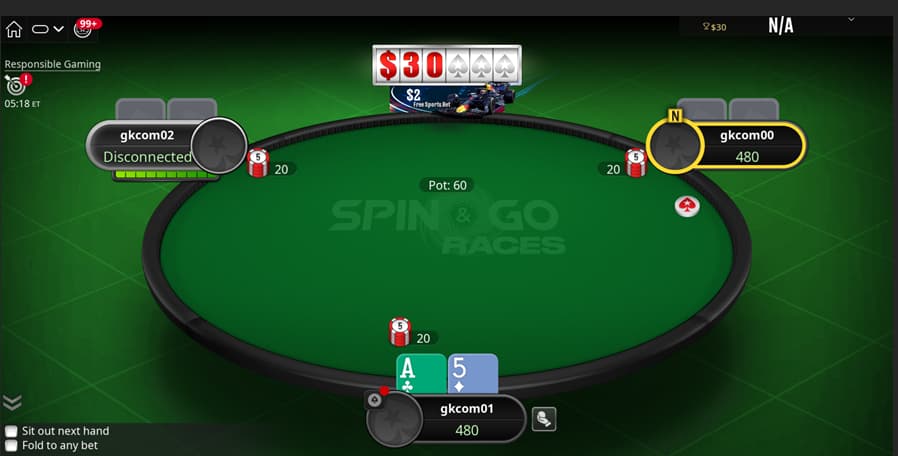Almost every modern poker strategy is more or less influenced by game theory optimal (GTO) findings. It’s hardly surprising; after all, GTO principles are proven to be unexploitable. Despite their usefulness, they are easily misinterpreted and may cause more harm than good.
What should you pay attention to while learning the GTO poker strategy?
If you want to find out more about what game theory optimal is or whether you should invest in the solver, we’ve already covered both topics.

Every hand starts at the preflop
Regardless of how you approach the game, a solid preflop game plan is the foundation for a sound poker strategy. Sometimes even a tiny mistake before the flop can snowball into a big, hard-to-navigate pot postflop. It’s a common sight when you play at a live poker table – many people, out of boredom, irritation, or lack of skills, play absurdly wide preflop and put themselves into very awkward spots on later streets.
Many poker tools can provide you with the optimal preflop charts, designed for thousands of the most common situations, and that count grows every day. It’s an excellent baseline for your game plan, as they will show you how your range of hands should look in certain situations.
You should remember two things, however.

If you are new to the advanced poker strategy, you shouldn’t throw yourself into the deep end
The optimal preflop ranges are calculated based on many factors, including the assumption that you’ll play GTO poker postflop. Obviously, that won’t be the case for any human being, so you should take your time expanding your preflop ranges. Treat hand charts as guidelines for your poker game. Do not turn them upside down to play GTO poker. Whenever you analyze or solve a hand, consider what your supposed range of hands should look like and how it looks in reality. If you are too tight or too loose, adjust towards the optimal strategy, but do not go bonkers with low-frequency opens with marginal hands just because the charts tell you to do so.
Most likely, your opponent’s range will also be pretty far off the GTO strategy
Whenever you study or review any hand, remember that your opponents are also people who are likely not playing GTO poker. It’s especially true when we talk about players you play against at your average, low-to-mid-stakes live poker table. The same will be true for most online poker players unless we take into account the highest available stakes.
Two conclusions can be drawn from this. The first is good news: the vast majority of the population is very far from playing the game theory optimal strategy, and that means there is a lot of room for creating an edge over them. The second insight is that you should consider the real behavior of the population you play against. Whenever you analyze a hand, do it twice, within the pure GTO settings and the hand ranges, and then take a look at both players’ ranges at each street and adjust it to the values that reflect reality best.
That will give you a broader insight: you’ll have an idea of how the GTO poker strategy looks for a particular situation, and you’ll also be aware of how to deviate from it if necessary.
Sometimes the exploitative strategy is the way to go in heads-up play
Poker solvers will provide the optimal lines of play for both players on all streets. But what if one player deviates heavily from the GTO strategy? Then the other player will be able to punish him severely.
Imagine two scenarios.
In the first one, you play a live cash game and open the pot preflop in the early position, and you get called in the big blind by a player with a very straightforward and tight strategy. The board is 654 with a flush draw. According to the GTO poker solvers, this board is favorable to the out of position (OOP) player, so they can lead into a preflop raiser or check-raise them a lot. In consequence, you, as a preflop aggressor, are supposed to play very passively and check back a lot.
If you are playing against someone who is unaware of what the GTO play in this situation is, you’ll be able to get away with betting almost all of your hands and profit immensely from that, even though, in theory, you’re not supposed to.
It also works the other way around.
Let’s say that this time, you are on the big blind, and the mentioned player was opening preflop, and once again, the board is 654 with a flush draw. Let’s assume that you adopt the pure check strategy (as correctly leading into the preflop raiser is one of the most challenging poker strategies to implement). If your opponent plays on autopilot and will c-bet this board with most of their holdings, you’ll be able to put them into a lot of awkward spots by check-raising almost every other hand.

The solvers are the most powerful poker software made to date
They will provide solutions to almost any poker question you can ask. The key to benefitting from that is asking the right questions and interpreting the answers correctly. There are a few essential assumptions you should have in mind whenever you use a solver or any other poker tool, for that matter.
Always double-check if the preflop ranges reflect reality
As we’ve mentioned, the preflop ranges are the key and fundament to fruitful poker study. Whenever you are solving a hand, make sure that the preflop play reflects what you or your opponent would actually do. Would you open as wide as the poker solver suggests? Would your opponent react at least similar to the optimal strategy?
Most likely, the ranges you play will slightly differ from the GTO poker assumptions. Take your time and correct that; it will make all subsequent calculations more accurate and useful.
Do not try to mimic the solver GTO strategy perfectly
Quite often, a GTO poker strategy is a very complex one. Sometimes, the solver mixes all of the actions for the same hand, which is impossible to mimic correctly by any human being. That’s why you should not strive to play poker ‘optimally’.
Whenever you get a GTO solution, focus on the broader picture. How often should you bet in a particular spot? What is the most preferred sizing? Which category of hands do you prefer to bet, and which would you rather check back?
The more broadly you think about the solver work’s results, the easier it’ll be for you to verify your current poker strategies.
Think twice about whether your actual opponents would take the same actions as the solver would do
It’s a continuation of the approach we recommended for the preflop ranges. Whenever the solver suggests you take a particular action, check if the assumptions made on the previous action align with what your human opponent would do.
Would your human opponent act in a similar way? Would they bet so wide, check-raise so often, or would they be way more passive? Quite often, especially in the most common situations, the solver’s assumption will overlap with the actual poker population. However, it’s always worth checking the GTO assumptions and tweaking them if necessary – that’s when you learn the most and improve against other players.
Learning GTO poker is not an easy task
It’s not impossible, though. Don’t worry if you are new to the game or do not immediately grasp the idea of the GTO strategy. It’s natural; game theory optimal is powerful and complex. Therefore it takes quite a long time to understand its principles.
Nowadays, there’s an abundance of free poker materials on the internet, which will definitely help you understand how poker solvers work and think. There is a faster way, however.
Join a poker school like Smart Spin. We’ve trained hundreds of players over the years, and our coaches are among the best players out there. Check our offer, join our welcoming community, and see for yourself!
